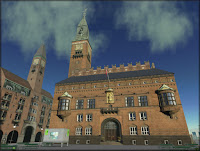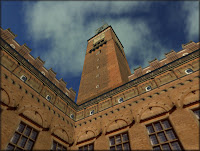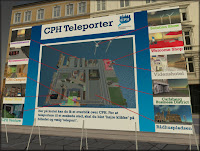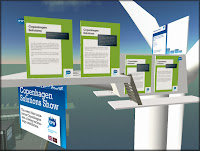Fancy a Danish? Virtual Copenhagen
This post was originally posted at 3pointd - but reprinted here with extra pictures.
2007 has seen a trend (dare I say “meme”? No, perhaps not) for real world cities to be replicated in the virtual world of Second Life. This trend has been particularly prevalent in Northern/Central Europe - with Germany and The Netherlands vying for the most virtual cities. Today, while passing by the World Trade Center Memorial again, I espied an island called »CPH«, and finding it open, went to have a look. It seems that the trend has moved North a tad, as this is virtual Copenhagen. But is it “wunderbar, wunderbar?”


There are many reasons why a city might want to establish a presence in Second Life. The context for Copenhagen’s build can be found in the related website, where you will find an English-language PDF file:
How can Copenhagen evolve into an international top rank knowledge city? A city, seething with innovation and enterprise. A city that is a magnet for students and knowledge workers worldwide. These are the questions we have worked on in the Think Tank for Internationalisation and Business Development. The Think Tank was set up by the City of Copenhagen in May 2006, under the initiative of Lord Mayor Ritt Bjerregaard. The result is nine concrete proposals spanning from a new hotel concept for researchers and knowledge workers to transforming Copenhagen into one huge exhibition of groundbreaking technology.These 9 concrete proposals are re-played here for the benefit of visitors, with many links to relevant pages of the website. The centrepiece of the island is Rådhuspladsen, or City Hall Square, and it is here that visitors first arrive. Teleports enable you to get to the various parts of the island where 3D visualisations of the 9 proposals can be found. The majority of the buildings on the island appear to be faithful reproductions of those to be found in the real city, including the City Hall (shown above). I know this can lead to endless debate about the merits or otherwise of trying to model real world buildings in Second Life. Personally, if there is a point and it is well done, then that is fine.
1. Copenhagen Campus is designed to attract international students and make Copenhagen a World-class university town.
2. The Welcome Shop is an international citizens service centre, where guest researchers, knowledge workers and students find everything they need to establish themselves in Copenhagen. Anything, from information about Copenhagen and Danish legislation to help with finding a job, accommodation and childcare.
3. A Knowledge Hotel is an accommodation service for international guest researchers and knowledge workers. It provides a place to live and a social network that will make you want to return to the city or settle down permanently.
4. The Potential Exchange is a place where people with unexploited potential come closer to the labour market. This could be a taxi driver with an engineering degree or a corner shop owner who is actually a trained doctor.
5. Smart Stars is a talent program for primary school pupils. The program will help pupils with poor odds and provide the talented ones with new challenges. The youngsters will learn that smart stars shine brighter.
6. Copenhagen has the potential to attract many more international firms. The Carlsberg district is one of the areas that have the largest potential. It could become an international power centre, housing the regional headquarters of large firms from Denmark and abroad.
7. Copenhagen’s urban spaces should be transformed into opportunity spaces, where there is room for creativity, diversity and enterprise. The key is collaboration between residents, those who use the city, developers, students and artists.
8. Copenhagen Solutions transforms Copenhagen’s urban spaces into a showroom of the best Danish technology and social solutions. An international magnet where one can see and experience the future.
9. Copenhagen Venture is an ambitious entrepreneur collaboration between the universities and the commercial sector. It aims at making Copenhagen a city seething with enterprise and new ideas.
Here's the selection of teleports and a couple of the visualisations:



The quality of the texturing and rendering of these buildings is very good - but for the most part they do lack a certain something: access. Aside from a school room (representing “Smart Stars”) I could not find any traditional buildings that I could actually enter. They seem to exist purely to provide a 3D backdrop for the presentation of the 9 proposals. I don’t see the aim as being to build any form of online community, although that may be planned for later. However, the use of Second Life both as a creative visualisation medium and as a promotional platform is well executed and interesting to see.
Of course, the real challenge is not is Second Life, but whether Copenhagen can achieve its objectives in the real world.


No comments:
Post a Comment